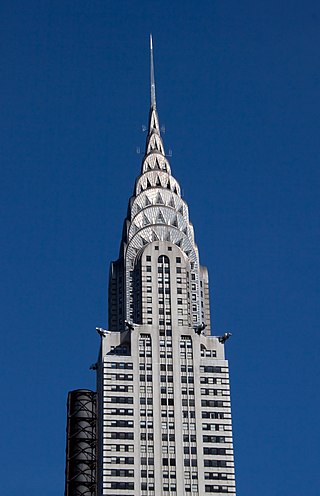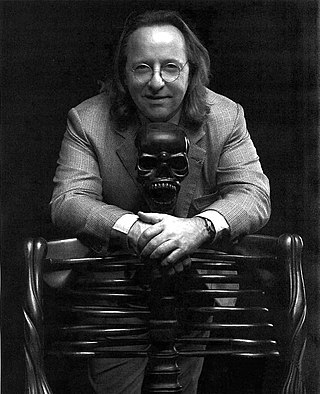
Art Deco, short for the French Arts Décoratifs, , is a style of visual arts, architecture, and product design, that first appeared in Paris in the 1910s, and flourished in the United States and Europe during the 1920s to early 1930s. Through styling and design of the exterior and interior of anything from large structures to small objects, including how people look, Art Deco has influenced bridges, buildings, ships, ocean liners, trains, cars, trucks, buses, furniture, and everyday objects including radios and vacuum cleaners.

The International Exhibition of Modern Decorative and Industrial Arts was a specialized exhibition held in Paris, France, from April to October 1925. It was designed by the French government to highlight the new modern style of architecture, interior decoration, furniture, glass, jewelry and other decorative arts in Europe and throughout the world. Many ideas of the international avant-garde in the fields of architecture and applied arts were presented for the first time at the exposition. The event took place between the esplanade of Les Invalides and the entrances of the Grand Palais and Petit Palais, and on both banks of the Seine. There were 15,000 exhibitors from twenty different countries, and it was visited by sixteen million people during its seven-month run. The modern style presented at the exposition later became known as "Art Deco", after the exposition's name.

Kelly Wearstler is an American designer. She founded her own design firm Kelly Wearstler Interior Design in the mid-1990s, serving mainly the hotel industry, and now designs across high-end residential, commercial, retail and hospitality spaces. Her designs for the Viceroy hotel chain in the early 2000s have been noted for their influence on the design industry. She has designed properties for clients such as Gwen Stefani, Cameron Diaz and Stacey Snider, and served as a judge on all episodes of Bravo's Top Design reality contest in 2007 and 2008.

Benoît-Pierre Emery is a French art director and a fashion designer based in Paris, France. He is also creative director of Objets et La Table at Hermès.
Emilio Rene Terry y Sánchez (1890–1969), known as Emilio Terry was a French architect, artist, interior decorator and landscape designer of Cuban-Irish ancestry. Creating furniture, tapestries and objets d'art, he was influenced by the château de Chenonceau, acquired by his family, and he created a style that was at once classical and baroque, which he called the "Louis XVII style".
Robert Couturier is a French architect and decorator best known for designing Cuixmala, formerly the estate of British-French billionaire Sir James Goldsmith.

Andrée Putman was a French interior and product designer. She was the mother of Olivia Putman and of Cyrille Putman.
Georges Geffroy was a post-war French interior designer.
Olivia Putman is a French designer, daughter to Andrée Putman and heir to her mother's design studio, Studio Putman. Her works range from interior architecture to scenography and design.
Timothy Corrigan is an interior designer with offices in Los Angeles and Paris. His firm, Timothy Corrigan, Inc., specializes in interior design and incorporates antiques into most of its projects. His clients include European and Middle Eastern royalty, Hollywood celebrities and corporate leaders.

Bill G.B. Pallot is an art historian, art expert, collector and lecturer at the Sorbonne University . He was honored with the French distinction of Ordre des Arts et des Lettres Chevalier (1997) and he is now Officier in the same distinction (2011). In 2016, he was indicted for making and selling false eighteenth century furniture, some of which were sold to the Palace of Versailles.
Roman and Williams Building and Interiors is an American-owned, New York-based design studio known for its work on hotels, restaurants, retail spaces, homes and product design. Founded in 2002 by Robin Standefer and Stephen Alesch, the firm encompasses Roman and Williams Guild New York (RW Guild) - a brick-and-mortar store of premium, artful home furnishings, accessories and housewares which include Roman and Williams' own product design collection as well as specially crafted pieces produced by artisans from around the world. The RW Guild stand-alone is also home to Roman and Williams' French restaurant, La Mercerie, helmed by Chef Marie-Aude Rose and Emily Thompson Flowers.

Pol Theis is a Luxembourger attorney and interior designer. He is the founder and principal of the international interior design firm P&T Interiors, which is based in New York City. Before pursuing interior design, he was a corporate lawyer, based in Luxembourg and Paris.
Joseph-André Motte was a French furniture designer and interior designer and ranks among the most influential and innovative figures of post-war French design.
Thomas O'Brien is an American interior and home furnishings designer. His design firm, Aero Studios, and home store, Aero Ltd., are both based in New York City's SoHo neighborhood.
Noé Duchaufour Lawrance is a French interior and product designer.
Joseph Dirand is a French architect and interior designer based in Paris.
Ralph Pucci is an American mannequin designer, gallery owner and entrepreneur.
Francis Sultana is a furniture and interior designer. He is regularly featured in the annual AD100 list compiled by Architectural Digest. The Times says he is "a furniture designer and decorating mastermind" and also mentions his famous clients. Financial TimesHow To Spend It magazine said "his baroque-meets-pop art style is making grand statements in an ever-widening circle of homes." Living Etc magazine describes Sultana's style as "luxurious, bespoke-driven and sumptuous". In 2018 Sultana was made Ambassador of Culture for Malta. He was named as one of the Top 20 interior designers by Wallpaper magazine and Top 100 Interior Designers by House & Garden magazine. The Financial Times said of his first hotel project La Palma Hotel, Capri for Oetker Collection that it is "a glamorous new start for Capri's oldest hotel ". In 2021 Sultana became custodian of The Hunting Lodge, the former home of British interior designers John Fowler and Nicky Haslam. ". As well as running his own atelier, Sultana is also CEO of David Gill Gallery ".

The Art Deco movement of architecture and design appeared in Paris in about 1910–12, and continued until the beginning of World War II in 1939. It took its name from the International Exposition of Modern Decorative and Industrial Arts held in Paris in 1925. It was characterized by bold geometric forms, bright colors, and highly stylized decoration, and it symbolized modernity and luxury. Art Deco architecture, sculpture, and decoration reached its peak at 1939 Exposition Internationale des Arts et Techniques dans la Vie Moderne, and in movie theaters, department stores, other public buildings. It also featured in the work of Paris jewelers, graphic artists, furniture craftsmen, and jewelers, and glass and metal design. Many Art Deco landmarks, including the Théâtre des Champs-Élysées and the Palais de Chaillot, can be seen today in Paris.









